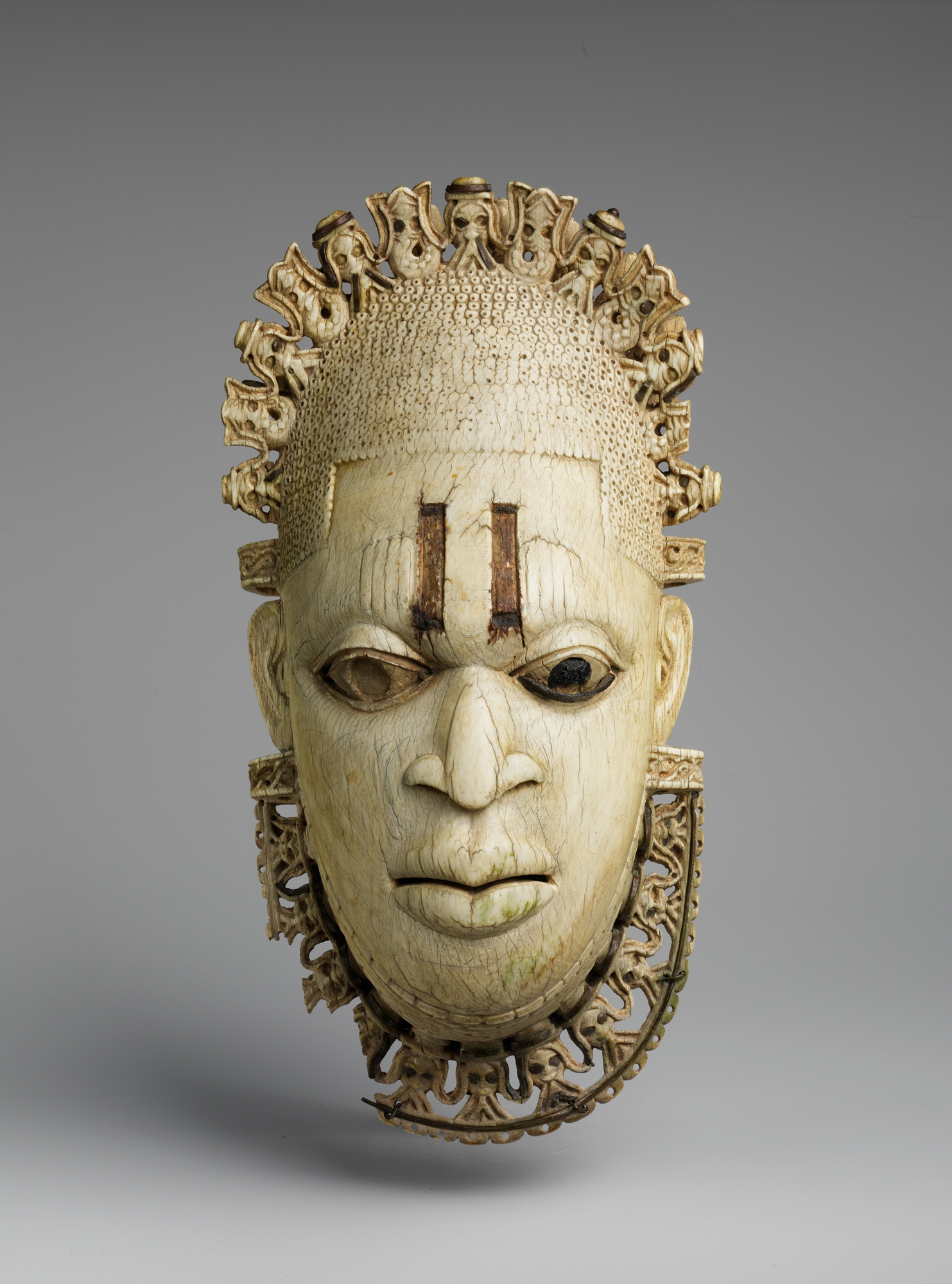
A replica of Nigeria’s Edo Queen Mother Pendant Mask: Iyoba, created in the 16th Century, was the symbol of the 1977 Second World Black and African Festival of Arts and Culture (FESTAC) in Lagos, Nigeria. This file was donated to Wikimedia Commons as part of a project by the Metropolitan Museum of Art. (CC0 1.0)
Editor’s note: First published on Yaba Left, this post is republished here with permission.
Lagos has always been Nigeria’s cultural capital. Given its maritime location as well as being the seat of political power in both the colonial and post-colonial eras, it was only a matter of time for the city to grow into its true cosmopolitan potential and become a place where people, ideas, and culture constantly collide.
Colonial accounts of pre-colonial musical forms are either sparse or glib. Narratives only become fluid at the instance of barter between western sailors and our ancestors, at the moment when musical instruments like guitars and horns became accessible to our communal sound and spirit.
Our knowledge of root forms remains rudimentary because change is constant and these changes mostly predate the grasp of technology. Precursor musical forms like sakara, asiko, apala, and agidigbo are still with us today, handled by old and aging practitioners who often pass it down bloodlines. However, highlife and juju music have been widely studied and documented, because they reached the height of popularity at crucial times in post-colonial history, a time of unfettered optimism and because it was also within the grasp of relevant technology.
Nightclubs in Lagos, dating back to the colonial times

The Campos quarter, in Nigeria's economic and cultural city of Lagos, was the home of freed saves who returned to Africa from Brazil, often with Portuguese names and a Christian religion. The area is now a lively, crowded, commercial part of town. Image by Carsten ten Brink, November 11, 2018, (CC BY-NC-ND 2.0).
Lagos, in the late 1940s, heavy with colonial presence, was not unlike any European city where nightlife thrived. The consequence of the interaction of natives and whites was the adoption of the latter's culture. Nightclubs in Lagos were vibrant and rewarding for the different players of its ecosystem—musicians, bands, promoters, food vendors, and drug peddlers—that made it function.
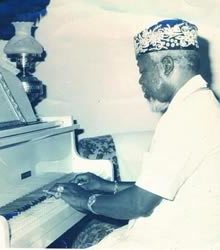
Bobby Benson (April 11, 1922 – May 14, 1983) was a Nigerian entertainer and musician. Image by Aymatth2 via Wikimedia Commons
Numerous accounts remember Caban Bamboo, the nightclub owned by Bobby Benson, a vibrant cultural entrepreneur and impresario of his time. He, alongside his wife Cassandra, ran a theatre group that served as nocturnal entertainment. He also formed the Jazz Orchestra Band, which later became a springboard and offered tutelage to Nigeria's greatest highlife musicians. At the time, this band played classical ballroom dance, foxtrot, cha-cha, and swing for their elite clientele. They also did local numbers too.
It was not until the 1950s that the wave of a new sound came by way of Ghana. There was the often-quoted West African tour embarked upon by E.T Mensah, a Ghanaian trumpeter, and his Tempos Band, which showed Nigerian musicians the possibilities of playing African-oriented rhythms with Western instruments. There are also accounts of Bobby Benson and his band traveling to Ghana to play shows. The origins of the name “highlife” from Ghana suggests that the music became accomplished in Ghana first.
What is conclusive about this era was that as Nigeria inched towards independence, highlife music grew in popularity. Nightclubs and hotels typically had resident bands who played most nights of the week and Saturday nights. The last Fridays of the month were particularly big.
Band musicians dressed dapperly in suits and provided music in popular venues in the city, including the Bobby Benson-owned Caban Bamboo, Gondola Bar (which still stands under a different name and ownership), and Ambassador Hotel both in Yaba owned by a Lebanese man.
A lot of these locations and exotic nightlife venues are defunct, having become residential buildings or church auditoriums. Their cavernous halls used to be a place of dance, music, and sexual liaisons. Women were huge cheerleaders of highlife musicians and had valuable roles in that niche, especially to the musicians. Songs like Rex Lawson’s ‘Sawale’ rush to mind, a humorous dance tune that curated the colloquial term, ‘waka waka baby’ to define commercial sex workers at the time. Many decades later, Flavour N’bania revisited this in an up-tempo song in his hit number called ‘Nwa Baby (Ashawo Remix).’
The 1960s, the golden era
The Golden Era of the 60s is fondly remembered as an era of independence and nationalist optimism and, highlife music, the popular dance music of the era, phased out calypso, classical ballroom dance, swing, and cha-cha to become the soundtrack of this period.
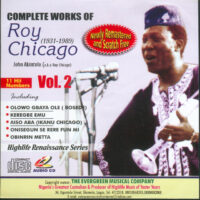
Album cover of Roy Chicago (1931-1989) highlife series
All over Nigeria, there were hotels and nightclubs where live music played deep into the night. There were charismatic band leaders with sophisticated band names. Roy Chicago (born as John Akintola Ademuwagun) and the Rhythm Dandies. Victor Olaiya and the Cool Cats. Fela Ransome-Kuti and the Koola Lobitos. Rex Lawson and His Mayor’s Band. Chris Ajilo and the Cubanos. Unfortunately, that optimism was short-lived. The newly formed republic fell into chaos leading to a civil war that left millions displaced and dead.

Victor Olaiya’s (1930-2020) ‘Papingo Davalaya’ album was released in 1986 by Premier Records
In the immediate aftermath of the Nigerian Civil/Biafran war, highlife music began its decline in popularity. A significant number of highlife musicians were of Eastern extraction and the war inadvertently displaced them from Nigeria into Biafran territory, which declared itself separate from Nigeria from 1967 to 1970. There was also the rise of American soul and funk music as well as the rising security concerns which hampered nightlife culture.
After the civil war, highlife struggled for relevance. Juju music, a variant of palm wine highlife, became more popular in South-Western Nigeria. With a flurry of musicians strumming the guitar and giving meaningful direction to the harmonies of their band members, this kind of music quickly became popular amongst the party-loving Yoruba elites.
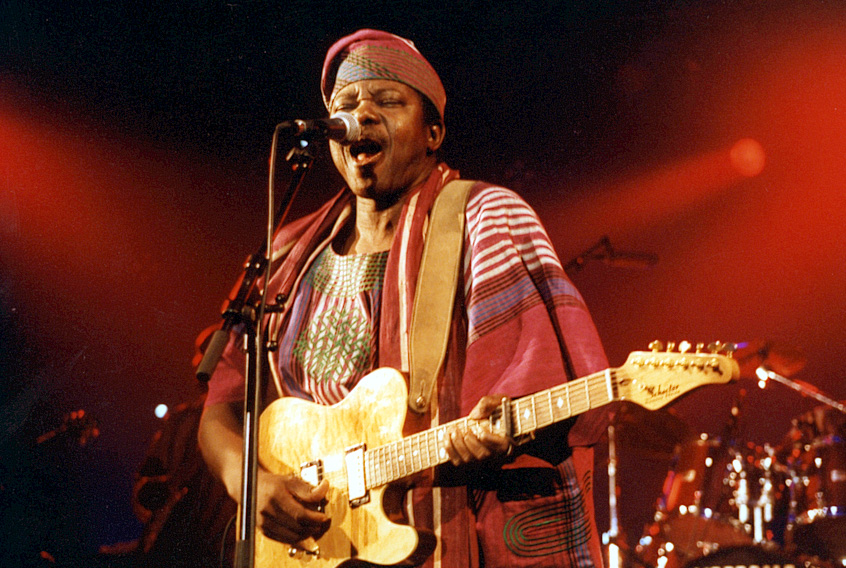
King Sunny Ade (born as Sunday Adeniyi Adegeye), Nigerian jùjú singer, songwriter and multi-instrumentalist. Image by master_xpo via Wikimedia Commons, September 12, 2005 (CC BY 2.0).
Regardless of juju’s slow speed in filling the void left by apala music — a percussion-based genre that originated in the 30s from the Yoruba people of south-western Nigeria — the impact of virtuoso musicians like the visually impaired Kokoro (born as Omoba Benjamin Aderounmu), Tunde King, Ayinde Bakare, Ojoge Daniel, JO Araba, and IK Dairo was not completely felt until the dominance of the duo, Chief Commander Ebenezer Obey and his dance-loving King Sunny Ade.
Several fusions like Afro-rock, Afro-soul, and Afro-funk were also in vogue among the younger crowd. The ‘70s would become a period of oil boom in Nigeria and the country, set back by an early 30-month long civil war, appeared resilient in its effort at espousing a cheerful disposition and forging ahead.
In 1977, Nigeria hosted the Second World Black and African Festival of Arts and Culture (FESTAC). Lagos was the landing for world-renowned creatives, including superstar American musicians, Stevie Wonder and James Brown.

“Sorrow Tears And Blood” by Fela Anikulapo-Kuti
Fela Anikulapo-Kuti, who was initially part of the FESTAC committee, boycotted the program. But his nightclub, Afrika Shrine, became a watering hole for a lot of international musicians who had come to Lagos on FESTAC’s bill.
Fela Kuti’s brand of music, Afrobeat, had become a staple on Lagos streets even if his incendiary lyrics put him at odds with the political class. His Afrika Shrine, doubling both as a nightclub as well as a spiritual Pan-Africanist nirvana, added a unique dimension to Lagos nightlife with a thriving ecosystem of food vendors, drug peddlers, and paraphernalia dealers.
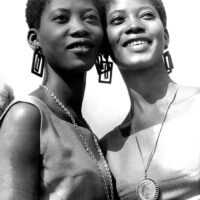
The Lijadu Sisters (Taiwo and Kehinde Lijadu) in Nigeria’s National Stadium, Lagos (1970). Image by Pade Aladi via the The Lijadu Sisters Facebook group
The 70s featured vibrant experimentation with sounds and musicians like Fela Kuti, Segun Bucknor as well as the Lijadu Sisters.
The Lijadu Sisters were identical twins whose music was a fusion of jazz, reggae, and the more traditional waka incantatory call and response music. Their music caught on and they quickly became pioneers among women musicians who upturned the abiding stereotype. Musicians were often looked upon as layabouts and this discriminatory gaze was especially harsh on women.
Emerging from an obscure colonial narrative, Nigerian music came into its own by the mid-20th century to glow in the golden cadence of self-rule, finally putting down roots firmly in the renaissance of pan-Africanism in the 1970s. This evolution was conceived, carried to term, and effectively delivered in Lagos, Nigeria's cultural capital.
Read the second part of this post here.






